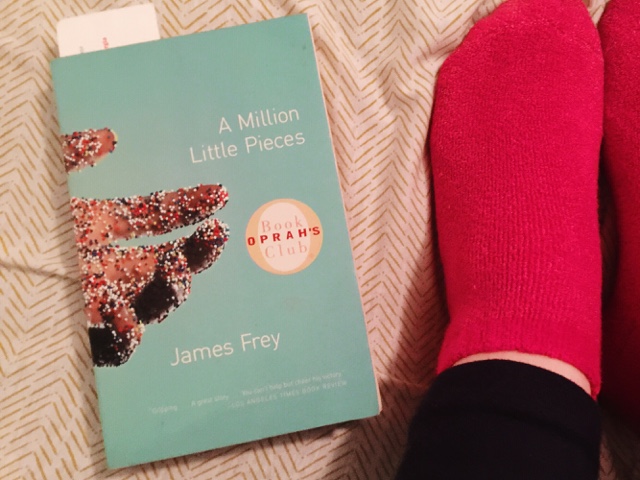The journey of recovery is immensely personal, often fraught with daunting obstacles and exhilarating revelations. In “A Million Little Pieces” by James Frey, readers are plunged into a visceral experience of addiction, desperation, and the profound quest for redemption. But what if you found yourself standing at the crossroads of self-destruction and renewal? This is the essence of Frey’s narrative, and it poses a playful question: How do we reconstruct our lives when the very fabric of our existence seems to be frayed and torn? The challenge here isn’t merely grappling with addiction; it’s the existential quandary of identity and resilience in the face of relentless adversity.
At its core, “A Million Little Pieces” is a novel that oscillates between brutal reality and tender introspection. Frey’s protagonist, who shares much of his life with the author, navigates a harrowing world of substance abuse. The book begins with an arresting image of a young man in the throes of addiction. He awakens on an airplane, disoriented and reeling from the visceral effects of substance abuse—an embodiment of the chaos that defines addiction. This opening scene sets a striking tone, compelling the reader to reflect on the fragility of human existence and the power dynamics within oneself.
As the story unfolds, we encounter a myriad of characters that populate the treatment facility, each a unique reflection of the struggle against addiction. Through Frey’s evocative prose, we witness the interplay between vulnerability and defiance. The stark reality depicted leads one to ponder: How does the environment shape an individual’s recovery journey? The characters serve as a microcosm of society, illustrating the varying landscapes of addiction, from the despair of alcoholism to the torment of drug dependency.
The narrative is unabashedly raw, involving instances of brutal honesty that can leave readers reeling. Frey does not shy away from depicting graphic details that might make even the most stoic squirm. Could this unvarnished representation of addiction serve as both a mirror and a magnifying glass for society’s perceptions of those struggling with substance abuse? The frankness encapsulated in his words delves into the heart of addiction’s complex nature and poses a challenge to the reader: Can we truly understand the depth of pain and the yearning for connection that accompanies such a tumultuous experience?
Moreover, Frey’s use of fragmented prose allows for a stylistic exploration that mirrors the disordered state of the protagonist’s mind. The book is peppered with poetic interludes and reflective moments that elevate it beyond a mere recounting of tales from a treatment facility. Instead, it transforms into an odyssey—one that thrusts the reader into a labyrinth of thoughts, emotions, and revelation. The question arises: Does this fragmented style enhance the authenticity of the narrative? As readers grapple with the disjointed syntax, they may find themselves aligning with the protagonist’s perspective—lost but desperately seeking coherence in chaos.
Another compelling aspect of the book is its exploration of the relationship between trauma and addiction. Frey weaves in moments of introspection that hint at deeper wounds beneath the surface—a past riddled with pain and suffering. The portrayal of trauma begs the question: Is addiction merely a symptom of underlying issues, or is it a stand-alone affliction? This inquiry challenges conventional wisdom, inviting readers to engage in a dialogue about the complexities of mental health, recovery, and societal stigma.
Interestingly, Frey’s book does not offer a prescriptive path to recovery; instead, it delves into the nuances of healing. The narrative is punctuated with moments of triumph and despair—an oscillation that underscores the non-linear nature of recovery. The juxtaposition raises an important point: Can anyone really pinpoint the exact moment they transition from despair to hope, or is it an episodic journey fraught with setbacks and victories? The reader is left to ponder the fluidity of recovery and the subjective experiences that accompany it.
While Frey’s account is intensely personal, it resonates universally, allowing readers across various spectrums to connect with the narrative. The book transcends the boundaries of its genre, appealing to those who have encountered addiction, trauma, or the quest for understanding in a chaotic world. It poses the ultimate challenge: How do we foster empathy and compassion in the face of struggle? Frey invites us to navigate this landscape, to challenge our biases, and to consider what it means to truly support someone on their path to recovery.
To imbue the reader with a sense of agency, Frey crafts a narrative that evokes questions rather than providing answers. This open-endedness encourages readers to reflect on their perspectives about addiction and recovery. Could it be that the journey toward healing is more about community and connection than sheer willpower? Perhaps the ultimate takeaway from “A Million Little Pieces” lies in its ability to spark introspection within the reader, guiding them to confront their beliefs and assumptions about human resilience in the shadow of addiction.
In conclusion, “A Million Little Pieces” is a profound exploration of the human condition, an invitation to reflect upon the complexities of addiction, recovery, and identity. By immersing readers in the tumultuous journey of Frey’s protagonist, the book does more than recount a tale of struggle; it artfully challenges notions of recovery and resilience. As we traverse the intricate web of human experience depicted in the pages, one is left to consider: What does it truly mean to be whole in a world that often feels fragmented? The challenge is ours to embrace, as we endeavor to find solidarity and empathy in our shared humanity.
